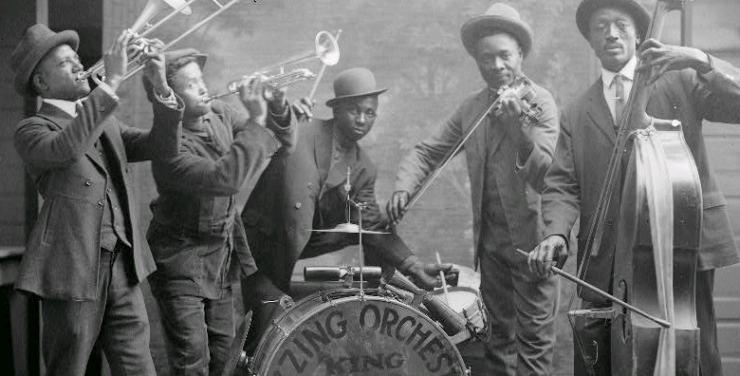Book Review: Jazz, Blues, and Spirituals: The Origins and Spirituality of Black Music in the United States

The new edition of our theological journal Foundations has just been published. Download the whole issue in pdf format here or read online here.
One of the articles is a book review by Andrew McKenna:
Jazz, Blues, and Spirituals: The Origins and Spirituality of Black Music in the United States
Hans Rookmaaker, 1960. Reprint, P&R Publishing, 2020, 242pp.
Challenges abound in reviewing a reprinted volume sixty years after its first publication. In many ways a work like this cannot be judged in relation to others in the field today. Yet the very fact of its re-issue allows the reader to examine its enduring contribution. This book serves as a challenge for those who share the author’s concern to treat all of life as God’s creation. When undertaking any cultural engagement from this standpoint, there is lots to learn from Rookmaaker’s approach (of his day) to jazz music. Positively, his passion for the music leads to a comprehensive mapping of the spiritual roots of jazz with a rare awareness of the different cultural factors affecting its development. Negatively, the author’s enthusiasm can lead him to strong, subjective judgments on the different historical sub-genres of jazz. The main challenge for the reader who wishes to engage this subject today is therefore clear: how to emulate such cultural awareness while ensuring that judgment is reserved until a fuller search for truth, beauty and idolatry is complete.
Hans Rookmaaker (1922-1977) was a Dutch scholar and contemporary of Francis Schaeffer. As well as founding the Dutch branch of the L’Abri Fellowship, Rookmaaker occupied significant academic and journalistic roles in the field of art history. His passion to encourage Christians to take culture seriously left a substantial legacy on evangelicalism that is still felt today. The fact that African American music was a passion rather than an academic pursuit does not render his contribution unimportant. In fact, in many ways he was an expert. However, when discussing the influence of various humanistic philosophies on the music, Rookmaaker does appear to revert to his comfort zone of the visual arts. This can sometimes result in philosophical labels being imposed too quickly on the music when, in reality, the visual arts have been further upstream than music in catching such influences.
The book is structured in a straightforward, chronological manner. It begins with a chapter on the origins of black music followed by chapters on the nineteenth century and the pre-war years of the twentieth century. As jazz develops at a greater pace from the 1920s, a separate chapter is dedicated to each decade from the 1920s to the 1950s. A unique feature is the accom-panying catalogue of recordings (complete with ratings) that Rookmaaker presents along the way to give examples of the various styles he discusses. The good news is that readers today need not possess such an extensive record collection but can make use of YouTube or the various music streaming services to get the full experience.
The strengths of the author’s approach are apparent in the first two chapters which contain an excellent study of the development of spiritual songs in the context of slavery. Care is taken when discussing the relationship between African music and Western music and Rookmaaker pays close attention to the religious syncretism that occurred as slaves arrived in South, Central and North America. This helpfully accounts for accompanying musical developments involving, for example, Spanish and French music of slave owners that was adapted by the slaves and gave birth to some of the Latin American genres. He also makes the shrewd observation that the sheer length of time of this slavery is part of the reason for the depth and subsequent development of the blues and then jazz, noting also that slavery and oppression continued in various forms beyond abolition.
Also in these early chapters, the author gives examples of the influence of Isaac Watts’ and even Wesley’s hymns on the early spirituals. Their popularity seems to have stemmed from the accessibility of the “lining out” style of singing, and from the lyrical content being straightforward without theological frills. The subject matter of a personal relationship with Jesus and the Christian hope was also appealing to the authors of the early spirituals. Making this connection provides a refreshing contrast to other standout histories of jazz which can often downplay or ignore the influence of these spirituals.[1]
As the historical survey continues for the remainder of the book, four other strengths are worth noting. Firstly, Rookmaaker commends the principle of engaging with black music on its own terms, rather than imposing the standards of Western music:
We must not apply Western standards in our assessment of quality. We must not expect to find refined modulations, for example, since there was no demand for it; neither can we expect subtle compositional solutions because this music was not designed for the concert hall, and also because these musicians lacked the relevant education. With such expectations we are barking up the wrong tree. The music was not Western music, played in a rough and crude manner; it was the birth of a new kind of music, African American music… (73).
This is also clear at various points when discussing the Western invention of “equal temperament” in music. Without such an influence, early spirituals and jazz music relied more on natural intonation and harmonies which the author helpfully describes as not inferior music but “a difference in musical thinking” (181). As such, he exhorts readers to not write off new music because we don’t yet understand it.
Secondly, Rookmaaker usefully teases out the biblical influences on the imagery employed in the spirituals, for example, the “sweet chariot” and its evolution into the “gospel train” – a device popular in songs and sermons of black churches from the 1920s onwards. Along with biblical imagery, biblical wisdom is shown to influence such spirituals in the way they portray a reality without pretence, reaping what is sown, and facing up to hardship (46-47).
Thirdly, light is shed on the complex and controversial issues of how, when and why African American music was employed by white audiences and even white performers. And fourthly, the author shows a good understanding of the great exponents of jazz and the blues who, in his view, are communicating truth and beauty through their music, informed as it is by God’s truth. These include King Oliver, Bessie Smith, Jelly Roll Morton, Blind Willie Johnson and Sister Rosetta Tharpe.
The main weakness in Rookmaaker’s work seems to be the way in which he readily enthuses about some styles and exponents of this music while labelling others as effectively without any redeeming features whatsoever. Normally these “thumbs down” opinions are accompanied by discussions of how such sub-genres or performers are tainted either by sentimentalism or by philosophical existentialism. He is obviously not a fan of Western Romantic music, which carries over to his criticism of some jazz and swing music, where he believes he spots philosophical connections. Thankfully, he is not always consistent with such criticism, arguing cogently on the dangers of writing off any style of music without weighing its value (178, 210-211).
Sixty years of musical history (including significant developments in jazz) have passed since Rookmaaker’s “publishing event” as William Edgar describes it in the new preface (vii). The very fact of its reprinting is a call for Christians with a passion for music to engage with jazz and other genres today. To stand on the shoulders of this particular giant will mean showing the same commitment to knowing and appreciating jazz or any music on its own terms. It will also mean going beyond the author in putting his own words into practice by being willing to understand and reserve judgment on unfamiliar music, even music we are suspicious of. It will also mean doing the hard work of searching for common grace among the various styles and artists, spotting the false gods that lurk beneath even our favourite music, and applying the gospel that is at the very source of this music to its expressions today. In doing so, there exists a real opportunity to point unbelieving jazz and blues enthusiasts to the Christ who brings true freedom, as some are already doing.[2]
Andrew McKenna, Associate Minister, ChristChurch Banstead, Executive Member, Music Ministry UK
[1] For example, Geoffrey C. Ward and Ken Burns, Jazz: A History of America’s Music (London: Pimlico, 2001).
[2] For example, Ruth Naomi Floyd (USA) and the Roots of Jazz (UK).
Stay connected with our monthly update
Sign up to receive the latest news from Affinity and our members, delivered straight to your inbox once a month.



